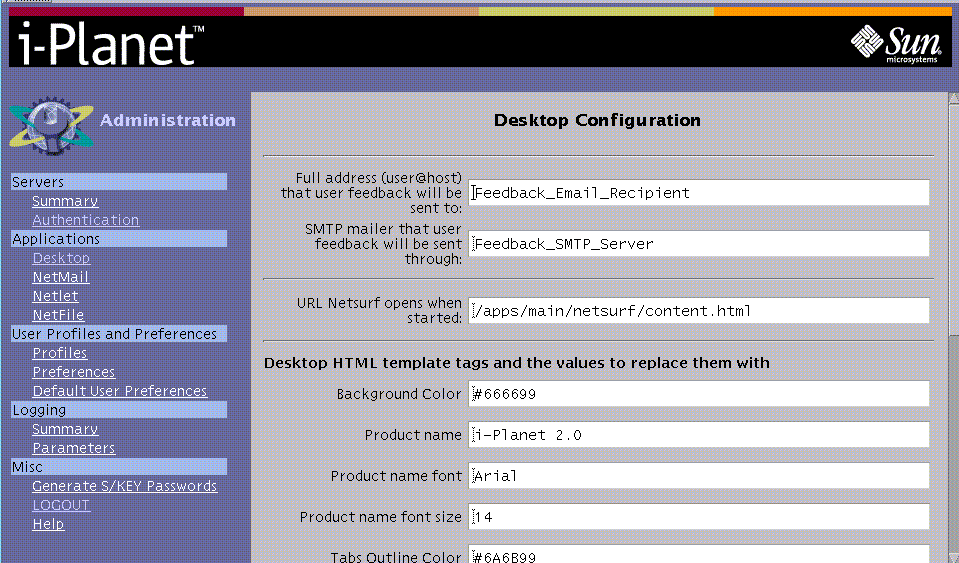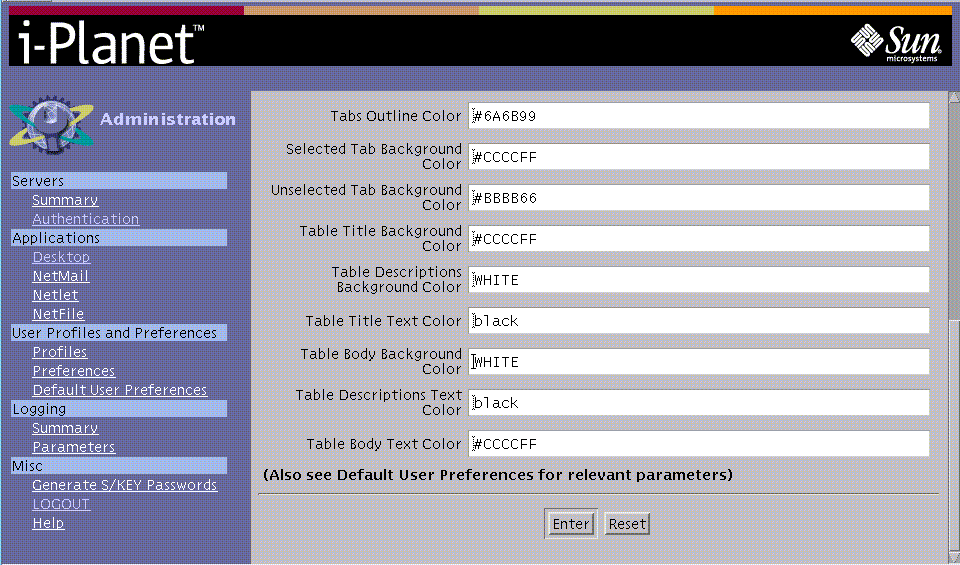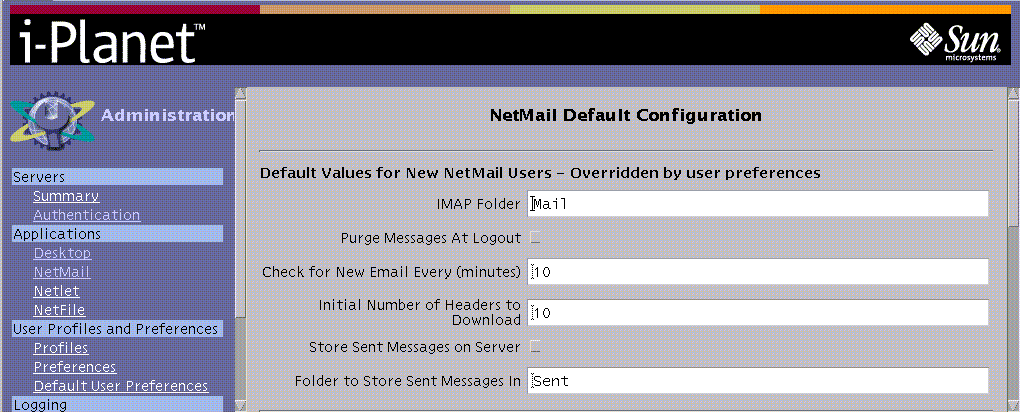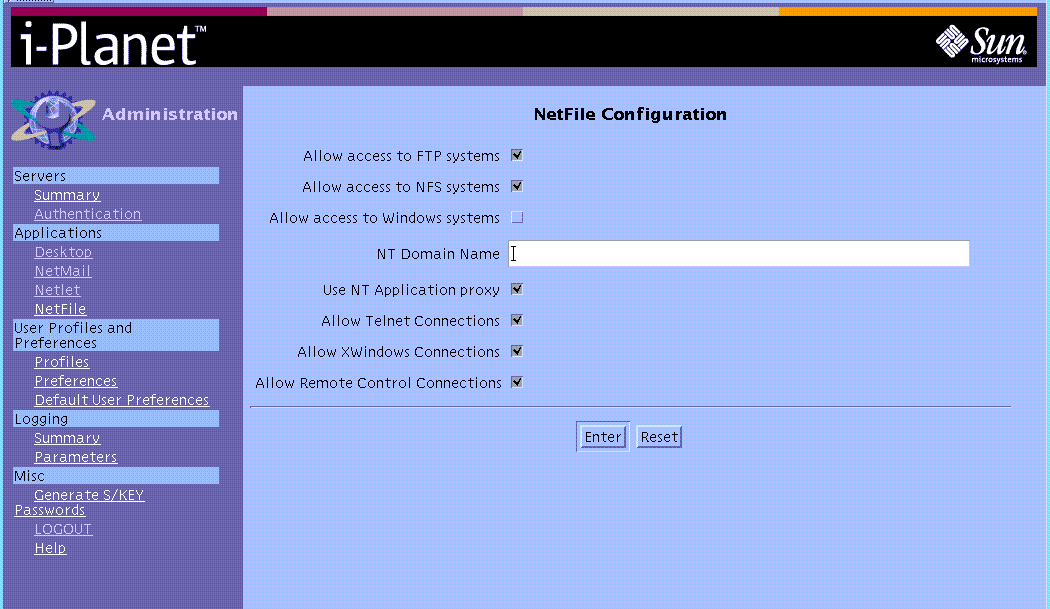Applications
This section contains links that allow you to modify or set values for configuring the i-Planet Desktop, NetMail, Netlet, and NetFile applications.
Desktop
Clicking the Desktop link displays the Desktop Configuration page, shown in Figure 2-7 and Figure 2-8.
Figure 2-7 Desktop Configuration--Upper Half of the Page

Figure 2-8 Desktop Configuration--Lower Half of the Page

You change the user i-Planet Desktop configuration by changing the values on this page. You can specify the:
-
Mailer (SMTP_host) that is used to transmit user feedback
-
Feedback address to which the end user's feedback will be sent
-
Initial URL that NetSurf will open when it starts
-
Values for Desktop HTML template tags
Colors can be RGB hexadecimal values (for example, #0000FF for blue), or an approved HTML word for a color. The HTML names and the RGB values are generally listed in any HTML reference.
You can test the changes by making them, stopping and restarting the web server, logging out of the Administration Console and, then logging in to the i-Planet Desktop.
Note -
If you change any of the parameters on this page, before you leave the page, you must click Enter to save your changes. After you have made all the changes in your editing session, you must stop and restart the web server for the changes to take effect. See the procedure "To Stop and Restart the Web Server on the i-Planet Server" in Chapter 3, Other Administrative Tasks.
Also see Default User Preferences in the "User Profiles and Preferences Section".
NetMail
Note -
If you change any of the parameters on this page, before you leave the page, you must click Enter to save your changes. After you have made all the changes in your editing session, you must stop and restart the web server for the changes to take effect. See the procedure "To Stop and Restart the Web Server on the i-Planet Server" in Chapter 3, Other Administrative Tasks.
Clicking the NetMail link displays the NetMail Default Configuration page for new users. It consists of two sections: Default Values for New NetMail Users - Overridden by user preferences and Default Values for New NetMail Users - Not overridden by user preferences.
The mail feature of NetFile from the i-Planet Desktop uses the preferences set by NetMail. Outgoing mail will be sent using the SMTP server that is defined in NetMail. You can change the mail settings through the NetMail preference dialogue or the end user can change them on the Preference page of the i-Planet Desktop.
-
Default Values for New NetMail Users - Overridden by user preference is shown in Figure 2-9.
Figure 2-9 NetMail Default Values for New NetMail Users - Overridden by User Preferences

End users can override these settings with information that they enter on the Preference dialogue for NetMail.
You can change the default new users settings, including the:
-
Name of the default IMAP folder
-
Enabling purging messages at logout
-
Time in minutes to check for new email
Set the time to check for new email so that it is greater than the Inactive Session time that you set on Authentication Parameters page. This will prevent failure to time out when the end users are using NetMail and NetFile until the maximum time out for the session is reached.
If you do not want the end user to be able change the time to check for new mail parameter on the Preference page of the i-Planet Desktop, type the parameter inactivityinterval from Table 2-4 in the Names of Uneditable Preferences field.
-
Initial number of headers to download
-
Enabling storing sent messages on the server.
-
Setting the folder in which to store sent messages.
-
Default Values for New NetMail User - Not Overridden by user preferences is shown in Figure 2-10.
Figure 2-10 NetMail Default Values for New NetMail Users - Not Overridden by User Preferences

-
HTML page link for help menu
-
Folder in which to store sent messages
-
LDAP Server --Lightweight Directory Access Protocol (LDAP) is a protocol that allows end users to have access to information from online directory services. By configuring NetMail to use directory services, end users can use the Address Search feature in the Compose Message window of NetMail to search for email addresses.
LDAP Parameters
You configure access to up to five LDAP servers through the Administration Console. Each parameter has the following form:
attribute,display name
You replace the values in italics as follows:
attribute--Attributes used to connect to the directory server.
Each attribute:
-
Has the form argname=argvalue.
-
Is separated by an ampersand (&).
-
Is URL encoded.
display name--Name of the directory that shows up in the Address Search tab of the Compose window. This name can be any sequence of characters that does not contain a question mark (?) nor a comma (,).
Table 2-2 shows the URL encoding in the attribute value.
|
Value |
Encoded as |
|---|---|
|
space |
+ |
|
plus sign (+) |
%2B |
|
comma (,) |
%2C |
|
percent sign (%) |
%25 |
You can use the arguments shown in Table 2-3.
Table 2-3 Arguments and Their Descriptions|
Argument Names |
Descriptions |
|---|---|
|
ldapserver |
LDAP server domain name. This argument is required because it specifies the domain name of the LDAP server to be searched. |
|
ldapport |
TCP port on which the LDAP server is listening. This parameter defaults to port 389. |
|
timelimit |
The maximum time in seconds that the LDAP server should spend searching. |
|
base |
The base argument for the search. Use the base argument to narrow the search to a specific area. An example of a base argument that specifies the base LDAP search parameters using URL encoding is: base=dc=Sun%2cdc=com |
|
binddn |
The dn (username) to use when accessing the LDAP server. |
|
passwd |
The password to use when accessing the LDAP server. |
|
scope |
One of base, one, or sub. This value specifies the type of search. The default value is sub. |
|
alias |
One of never, search, find, always. This value specifies how to handle aliases. The default value is never. |
You must end the last argument with an ampersand (&) because the NetMail (Java) applet adds arguments for the search string and the count to the URL before doing the search.
Example One
The following parameter is an example that references the InfoSpace LDAP server:
ldapserver=ldap.infospace.com&,Infospace LDAP
Because the LDAP parameters are in the Administration Console, every user gets the same LDAP server list.
Example Two
The following parameter is an example that references server x with options.
ldapserver=srver.com&ldapport=1449&binddn=username&passwd=password&alias=find,An LDAP server
When you use Netmail's Address Search feature to obtain access to a directory service, the LDAP request is passed to the web server that runs the LDAP CGI program. The CGI program requests information from the LDAP server. The web server must be able to communicate with the LDAP server. If the web server and the LDAP server are both behind a firewall, NetMail users can still search the directory even if they are outside the firewall.
Configuring Names of Uneditable Preferences
You can enter any or all of the parameters shown in Table 2-4 in the Names of Uneditable Preferences field on the page for Default Values for New NetMail Users in the Administration Console. The end user cannot change these preferences. Multiple values are separated by commas. The preferences that you enter will not be visible as editable values in NetMail's Preferences dialogue.
Table 2-4 Names of Uneditable Preferences for NetMail
Note -
The values you specify for the parameters in the NetMail of the Administration Console override the default values.
Netlet
Note -
If you change any of the parameters on this page, before you leave the page, you must click Enter to save your changes. After you have made all the changes in your editing session, you must stop and restart the web server for the changes to take effect. See the procedure "To Stop and Restart the Web Server on the i-Planet Server" in Chapter 3, Other Administrative Tasks.
This is the client program that works together with the reverse proxy server on the i-Planet gateway to allow secure access from the Internet to TCP/IP application on your intranet. You can specify which predefined application rules will be enabled as well create rules for your own TCP/IP applications that you want to access through the Netlet.
Clicking the Netlet link displays the Netlet Administration page, shown in Figure 2-11.
Figure 2-11 Netlet Administration Page

Note -
The predefined Netlet rules work in conjunction with NetFile. For them to be active, you must enable them on this page and on the NetFile Configuration page.
The Netlet Administration page shows the predefined applications and provides a the place and the means for writing user-defined Netlet rules (up to a limit of 30).
The predefined function and rules are:
-
Port Warning--Enables or disables support for a warning window that displays from the NetFile page of the i-Planet Desktop application when a connection to a Netlet port is being attempted. The Netlet Connection Attempt window also shows the number of the port. The end user can then decide to:
-
Click OK to continue
-
Cancel to stop the connection
-
Choose not to see this warning again, which disables the port warning for the current session only.
-
-
Predefined Netlet Rules--Enables or disables support for the applications listed.
The destination system is given at runtime through the NetFile application. You must also enable the Netlet functions on the NetFile Configuration page. The defined applications are:
-
Telnet--allows end users to use Telnet to have access to systems on the intranet. Addresses for Telnet are established dynamically, if you are using NetFile. The Telnet client is the one that is configured in the client browser.
-
GO-Joe (remote X-Windows)--allows end users to use GO-Joe for remote X-Window control for the Solaris operating environment. GO-Joe is a thin client X server that uses a three-star, distributed client-server architecture (X server, X client, and display applet). The GO-Joe server must be installed on the destination machine. Information on the requirements for installing GO-Joe is in the section "GO-Joe " in Appendix C, Third-Party Software.
-
NT-Applications (Citrix)--allows end users to use Citrix-based applications over the Internet. Citrix reserves port 1494. Citrix has Java and non-Java clients that support TCP/IP. i-Planet is customized to start the Citrix client (Java applet) and a Citrix-based proxy when you configure it appropriately.
Note -If your end users will be connecting to any a Microsoft Windows-based machine using NetFile, you must first install the Samba software that is on the i-Planet CD-ROM, "Contains 3rd Party Software Packages Only," on the i-Planet server.
-
pcANYWHERE (a Windows 95, 98, and NT remote-control product)--Allows users to have remote PC Microsoft Windows control. Information on installing and configuring pcANYWHERE is in the section "pcANYWHERE" in Appendix C, Third-Party Software. The pcANYWHERE client (Java applet) software is installed with i-Planet. A demonstration copy of the pcANYWHERE server software is on the i-Planet CD-ROM, "Contains 3rd Party Software Packages Only." If you enable this option, you must buy a copy of the server software and install it on the computer that your end users want to control remotely.
The i-Planet product also supports the software CarbonCopy, LapLink, RapidRemote, ReachOut, RemotelyPossible (all Microsoft Windows 95, 98, and NT remote-control products). If you want to use them, you must buy these products separately.
Table 2-5 shows the ports that are reserved for the predefined Netlet rules. Do not use these reserved ports in writing your own Netlet rules.
Table 2-5 Reserved Listen Ports for Predefined Netlet rules
loopback is required because of the Java security model. Applets are only allowed to make connections back to the server from which they were loaded. In order to make the included client applets work with the Netlet, they must appear to be downloaded from server localhost. This is accomplished by telling the Netlet to fetch the desired applet. Traffic requests on the loopback port are requests to the Netlet to go back to the i-Planet server and download the object whose path is given in the URL.
-
User-Defined Netlet rules--You define the user-defined Netlet rules in the lower half of the Netlet Administration page, shown in Figure 2-11. The end user cannot dynamically specify a destination server at run time. The destination server is fixed. You must define the whole path for them.
Note -You are limited to 30 user-defined rules.
The syntax for defining these applications is: name^client-listen-port^destination-host^destination port, in which:
-
The symbol "^" is the field separator in this syntax.
-
name--some identifier for this entry. It is only used to track the application.
-
client-listen--the port for which the Netlet listens on the end user's client machine.There can be only one entry or rule for each client-listen port
-
destination-host--the name or IP address of the destination host to which traffic will be directed.
-
destination-port--the port on the destination host to which all traffic will be directed.
Note -You cannot assign a port number greater than 64000 when you are defining your own Netlet rules.
For example, the following procedure shows how to write a Netlet rule that will allow telnet traffic to a specific system.
To Write a Netlet for Special Telnet Handling
-
Write a Netlet rule for special handling of Telnet in one of the fields for writing user-defined Netlet rules, as follows:
telnetspecial^23^machine-on-the intranet^23
-
Click the Enter button at the bottom of the page to save this Netlet rule.
This Netlet allows Telnet traffic from any remote machine and directs it to machine-on-the-intranet. Any normal Telnet traffic on port 23 (the destination Telnet port) to the machine on which the netlet is running will be redirected to machine-on-the-intranet. You can specify different names or port numbers, depending on your requirements. You must not have any other handler for port 23 for this to work (that is, no Telnet service/daemon specified).
-
As root on the i-Planet server, stop and restart the web server so that the Netlet rule you just defined will take effect.
See the procedure "To Stop and Restart the Web Server on the i-Planet Server" in Chapter 3, Other Administrative Tasks.
Note -If you monitor incoming or outgoing traffic through your firewall, you will see that all Netlet traffic on the outside actually passes on your SSL port (likely 443). The TCP protocols used by the Netlet rules are tunnelled through your SSL port.
NetFile
Note -
If you change any of the parameters on this page, before you leave the page, you must click Enter to save your changes. After you have made all the changes in your editing session, you must stop and restart the web server for the changes to take effect. See the procedure "To Stop and Restart the Web Server on the i-Planet Server" in Chapter 3, Other Administrative Tasks.
Clicking the NetFile link displays the NetFile Configuration page shown in Figure 2-12.
Figure 2-12 NetFile Configuration Page

Note -
For defined applications on the Netlet Administration page to be active, they must be turned on here and on the Netlet Administration page.
Allow Access to FTP, NFS, Microsoft Windows, and NetWare Systems
These options enable or disable support for access to FTP, NFS, Microsoft Windows, and NetWare systems. You must obtain the NetWare software separately. NetFile will automatically detect the type of file system for a selected system. Access to a system that supports multiple access types is assigned in the following order:
-
Allow access to Windows systems
-
Allow access to FTP systems
-
Allow access to NFS systems
-
Allow access to NetWare systems
Note -The information for NetWare will only appear on the NetFile Configuration page, if you have installed NetCon 7.0 from the NetCon Corporation on the i-Planet server. You can use NetCon 7.0 only with Solaris 2.5.1. and 2.6.
The machine type is determined by seeing if a connection can be established to well-known ports. For example, 139 is used for Microsoft Windows networking (for Windows `95, `98, and NT), 21 is used for FTP, and 2049 is used NFS.
If, for example, a system can be reached through Microsoft Windows networking, then it will treated as a Microsoft Windows system, regardless of whether or not it can also be reached through FTP.
Note -If you have not installed the Samba software to allow access to a Microsoft Windows network, then enabling Microsoft Windows system setting on the NetFile Configuration page will not provide end users access. The Samba software is on the i-Planet CD-ROM, "Contains 3rd Party Software Packages Only."
-
NT Domain Name--Enter the name of the NT domain that provides authentication to your Microsoft Windows network.
All of the remote windowing functions and applications below are only available through the Java version of NetFile.
-
Use NT Application proxy--Enables or disables Netlet support for a Citrix-based proxy.
-
Allow Telnet Connections--Enables or disables Netlet support for Telnet access to the hosts that the end users select.
-
Allow X Windows Connections--Enables or disables Netlet support for X Windows. It allows an end user to run an X Window session over the Internet. The GO-Joe client software is included with the i-Planet server. For more information on GO-Joe, see Appendix C, Third-Party Software.
-
Allow Remote Control Connections--Enables or disables Netlet support for remotely controlling Microsoft Windows Desktop systems. The supported remote control products are listed in "Netlet" section of this chapter.
All remote control software (except pcANYWHERE) must be configured to send all traffic to localhost. The Netlet will intercept this local traffic, encrypt it, and route it through the i-Planet proxy. If end users want to use pcANYWHERE software, they must install the pcANYWHERE host on the PCs that they want to control remotely on the private network. See the section "pcANYWHERE" in Appendix C, Third-Party Software for instructions on installing and configuring pcANYWHERE.
Note -
With pcANYWHERE's Java client, you do not need to install client software.
End users must install the appropriate client remote-control software on their local PC and appropriate server software on remote systems, if they want to use a remote-control application. (The GO-Joe server software is included on the i-Planet CD-ROM, "Contains 3rd Party Software Packages Only.") They should check the documentation of the remote-control application for any requirements.
End users should verify that the remote-control software is working properly before attempting to use it through i-Planet.
- © 2010, Oracle Corporation and/or its affiliates
